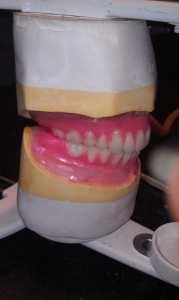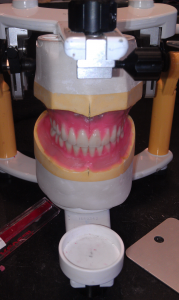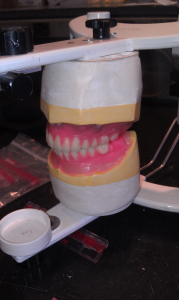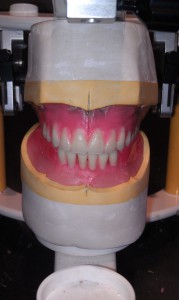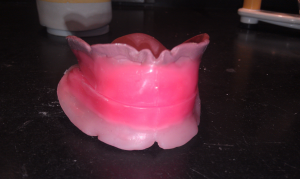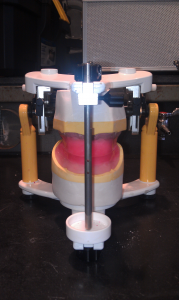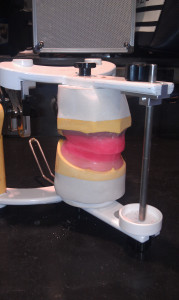The set-up of mandibular anterior teeth are as follows:
You might notice that these steps are fairly similar to the maxillary set up of the anterior and posterior teeth.
1: First you do the same as you did with the maxillary and cut out a block of wax using you’re roach carver. for the two mandibular centrals.
2: Next you take and place them in making sure that they are at least 1mm away from the maxillary centrals horizontally.
3: If they do not fit you may need to take a hand piece and grind down the baseplate a bit. That way you can have room for them so they will not be up too high. Make sure that they are level with each other.
4: Next you Cut out another block of wax with you’re roach carver and place the laterals in right nest to the centrals, also making sure that they are level with each other.
5: Next its time to put in the canines. These teeth potrude out just a hair so they can protect the postrior teeth. they are just a bit above the centrals and laterals.
The set-up of Mandibular Posterior teeth are as follows.
1: As you are aware you must cut out the bloc of wax for you’re two pre-molars on the left and right sides.
2: Next you position them according to the curve of spee and the curve of the teeth naturally making sure that the occlusion for the Maxillary and mandibular casts are aligned correctly. It should be in a U shape.
3: Just as the maxillary should be in an upside down U shape.
4:Next are the left and right lower first and second molars. Y0u must cut out the wax again and place the first molars in the spots next to the second pre-molars. Then following the same procedure for cutting out the wax you place the second molars next to the first molars on the right and left sides.
5: Make sure that these teeth are slightly on an upward curve because they are following the teeth on the opposing jaw. which is creating the curve of spee. Next you cut out another piece of wax with you’re roach carver for the third molar.
6: After you cut out room on both sides first see if you are able to fit the molars in. ONLY if you are able to fit them in and have perfect occlusion you are ready to festoon.
7: If not you have to remove the third molar take a hand piece and gently grind away at the tooth. BUT make sure that it is not the occlusal surface that you grind away. Make sure it is the side you are putting into the wax.
The steps for Festooning are as follows:
1: Lastly after finishing both maxillary and mandibular set- up of you’re teeth you are ready to festoon
2: You must hold you’re roach carver on a 45 degree angle so you do not create food traps. also make sure you do not have any diastimas (space between the teeth causing gaps)




